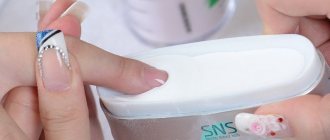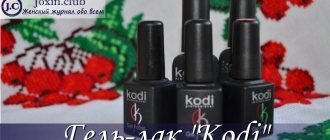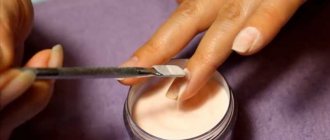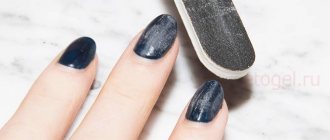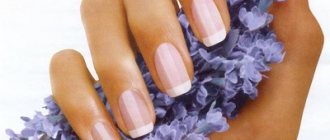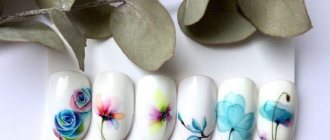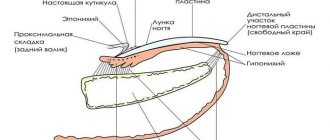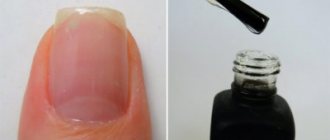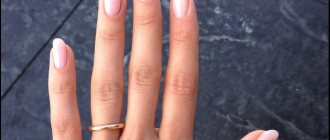Base and top are irreplaceable elements of manicure and, perhaps, the most important. The durability of a nail design directly depends on good base and top coats. How to choose them correctly? Does quality depend on price? Can expensive products cause allergies? We want to answer all these questions and for this we have compiled a rating of the best bases and tops in 2021!
Let's take a quick look at the definitions. Nail base is a preparation that acts as a layer between the artificial coating and the nail plate. The base also hides nail imperfections and allows the colored gel polish to lie as smoothly as possible.
Nail top coat is a gel polish fixer. As a rule, it is colorless and performs protective and decorative functions. It is applied as the final stage of manicure and is also called finishing.
We have prepared this list based on reviews from real customers, personal sales statistics of KrasotkaPro, open data from the Yandex search engine. Attention: since brands, as a rule, have several product lines, in our rating of the best we consider not a specific type, but all products from one manufacturer in the aggregate.
The criteria by which we evaluate the bases and tops of each brand:
- Durability
: the base and top should last at least 2 weeks and ensure the durability of the manicure. - Comfort to use
. A consistency that is too thick or too thin can complicate the process of applying and distributing the material over the nail plate. The shape of the brush and the smell of gel polish can also make the procedure more or less pleasant for both the master and the client. You can also note the time required for removal with liquid. - Composition
: it must be safe, and the base and top must not cause an allergic reaction. - Cost
: Saving money is always good, but we're looking for the perfect example of value for money.
Point system:
By quality
- 2 points for comfortable use (consistency, brush = 1 point, lack of strong odor = 1 point);
- 1 point for every 2 weeks of durability (if 4 weeks, then 2 points, etc.);
- 1 point for no allergy complaints.
By cost
- 4 points for costs up to 300 rubles;
- 3 points for a cost from 300 to 600 rubles;
- 2 points for a price from 600 to 900 rubles;
- 1 point for a price over 900 rubles.
By popularity
- 6 points for more than 10,000 queries in Yandex per month;
- 5 points for 8,000-10,000 queries in Yandex per month;
- 4 points for 6,000-8,000 queries in Yandex per month;
- 3 points for 4,000-6,000 queries in Yandex per month;
- 2 points for 2,000-4,000 queries in Yandex per month;
- 1 point for less than 2,000 queries in Yandex per month.
After we cover each of the 10 best nail base and top coat manufacturers and assign points, we will collect all the data in a common table. Please note that several funds can be located in the same place at once - it all depends on the number of points.
Why do you need a base?
It is the base that holds the gel polish on the nails. It acts as a layer between the natural nail and the polymer coating.
The base is in direct contact with the nail. Not gel polish, but a base. Therefore, it is very important to choose a base that will hold the gel polish firmly on the nails, but will not harm the nails.
The base coating is designed to protect the nail plate from coloring pigments in gel polishes, smooth out all defects on the surface of the nails, and ensure reliable adhesive bonding of the polymer material to the nail.
Another important function of the base is to strengthen the nail plate. The natural nail may be weak, thin, or bend and break. All this will not allow the coating to last on the nails for the required 2-3 weeks. A properly selected base will strengthen and protect even the thinnest and weakest nails.
Detachments, chips, cracks - all this can happen due to a poorly selected base.
The best camouflage bases for gel polish
Naturalness is in fashion, so nude tones are at the peak of popularity. This type of base can hide plate defects and is ideal for creating a gentle French manicure. You can also choose a multi-functional product that contains rubber, which will allow you to even out your nails. Manufacturers offer translucent, matte and transparent options.
Vogue Nails Ultra
- The most beautiful design
- Country Russia
- Price: 550 RUR
- Rating (2021): 8.6
This camouflage base has optimal density, so you can get by with just it and not apply additional gel polish, which will save time. Many women note the increased thickness of the product, so beginners should adapt; it may not be possible to apply it the first time without defects.
Advantages
- Design
- Design
- Natural shades
Flaws
- Almost does not drip from the brush
Runail Elastic base
- Optimal durability and price
- Country Russia
- Price: 280 RUR
- Rating (2021): 9.0
The domestic production base is a real boon for those who care about the family budget. Despite the low price, the product has increased durability. It can be dried in any lamps.
Advantages
- Reasonable price
- Excellent durability
- Very easy to use
Flaws
- May cause cracking when combined with products from other brands
POLE Color base
- The most pleasant smell
- Country Russia
- Price: 350 RUR
- Rating (2021): 9.3
The rating of the best bases for gel polish is completed by a product with an amazing banana scent. The manufacturer's palette includes fashionable pastel shades. The base is quite dense in terms of pigment, so it can be applied in one layer; when creating a French coat, it is better to apply two. The product has a medium consistency, which eliminates spreading and ensures ease of application.
Advantages
- Pleasant aroma
- Nude tones
- Optimal viscosity
Flaws
- Not suitable for everyone
Differences between liquid and thick bases
Liquid bases are highly durable. They practically do not shrink on long nails. Suitable for craftsmen with experience, because... Due to its liquid consistency, the nail plate must be leveled quickly, otherwise streaks cannot be avoided.
I remember how freaked out I was when I just started working, and not yet understanding the intricacies of choosing a base. I bought something cheap, very liquid and smelly. Later, I learned to work with liquid bases, and realized that they are not suitable for all types of nails. A strong smell is a sign of a not very good base.
Liquid base is good for strong, healthy nails. With a pronounced apex. On bendable, soft nails, the base can cause detachments and chips.
And yes, you cannot extend your nails with a liquid base.
Thick bases - they are also called Rubber (which is translated from English - eraser, i.e. these bases are elastic), and not rubber, as many masters like to call them. Due to their thickness, they are easy to work with and the leveling is perfect. Also, with the help of a thick base, you can extend your nail without any problems. Great for weak, easily bending nails. The only disadvantage of this base is that it shrinks on long nails, and the longer the nail, the more it sinks. This feature must be taken into account.
After the second week of wear, the coating begins to sag, and the architecture of the nail is disrupted.
Rubber base: characteristics and application features
The rubber base is thick or has a medium texture due to the liquid rubber contained in the composition. It is also made self-leveling, transparent or colored. This type of product almost does not spread when applied, gives nails strength, and protects against chipping of varnish particles and peeling.
Another advantage of many products in the range is comfortable drying in a lamp, without pain. The main thing is not to overdo it with the amount, apply the product evenly to all nails, which is easy to check by looking at the glare. And with the help of a rubber base you can perform extensions.
Additional conditions for high-quality application of the base:
- the end of the nail should be thin, especially if the previous coating was removed;
- the correct architecture of the plate, that is, its highest point is in the central part, neither higher nor lower;
- the right choice of the product itself - for beginner nail artists, thick is better, experienced ones need to focus on their own speed of work;
- the amount of material should be optimal so that it is enough for the entire plate, but it does not lie in a lump;
- covering the entire nail area, but not under the cuticle.
How is it different from the usual
Rubber base and regular base are incomparable; what the difference is is easy to understand by assessing each according to several criteria:
- The first is used for different types of nails, including wavy, “rag”, prone to brittleness. With its help you can level their surface. The second one will be useless for problematic nail plates. It is more suitable for healthy, strong, smooth surfaces, as it does not have leveling properties.
- The rubber base not only holds weak, bendable nails well, but also allows you to wear long-lasting manicures for a long time. The regular one does not provide such support. The length may break with it.
- The texture of the rubber base allows it to be applied quickly in 2-3 strokes. The usual one needs careful even distribution with a brush; often you need to apply two layers.
- Rubber takes longer to dry in the lamp, but many products in this category eliminate discomfort during the procedure. Most regular bases cause a burning sensation when drying.
- Some types of rubber base are suitable for extensions. A regular substrate will not perform this function.
Will nails be strengthened?
Strengthening nails with a rubber base occurs due to strong adhesion to their surface. The product becomes like another layer of plates. The flexibility of the base allows them to avoid breakage under impact loads and during growth. This is a durable but gentle frame for marigolds.
How to use
Using a rubber base is also more convenient than a regular liquid one:
- First, take a small drop of the product, and shake off the excess back into the bottle.
- Coat the plate with a thin layer over the entire surface, that is, make 3 strokes.
- Then you need to take another drop of material and place it in the middle of the nail.
- All that remains is to distribute it evenly over the entire area with quick wave-like movements and send your hand into the lamp.
The rubber base should be applied to buff-treated and grease-free nails.
Watch this video on how to use a rubber base for gel polish:
Is it possible to extend nails
You can use a rubber base to extend your nails if you want to make them a little longer. The product must be hard when dry, that is, from the structure or builder series. The process consists of the following steps:
- A form for extension is placed on the prepared nail.
- A primer or dehydrator is applied to half the plate and allowed to dry.
- Use a thick layer of base on the free edge of the nail, modeling its continuation (put a drop in the middle and smear it on the sides).
- The hand is placed in a lamp to polymerize the composition.
- After it dries, remove the form.
- The base is applied in a thin layer to the entire surface of the nail.
- Then take another drop of the product and make an additional, denser layer, without lifting it, moving the brush from the center to the right and left.
- The product is polymerized again in a lamp.
- After removing the sticky layer, the extended nails are filed to give the desired shape and remove defects.
Watch this video on how to extend nails with a gel polish base:
Why does the coating sags?
Gel polish bases consist of polymer chains that are formed as a result of a polymerization reaction. This process is completely completed only after a few hours or even days. When polymer chains are formed, the molecules come closer together, the distance between them decreases and they take up less space. This is how the material shrinks. Polymer chains have formed, but this is not the end of the polymerization reaction and not the end of the shrinkage of the material. This is clearly visible on the nails 2 weeks after application of the coating. The material begins to sag. This is especially noticeable on the free edge of the nail. The shrinkage causes the tip of the nail to twitch, which visually increases the dip. It is because of the shrinkage of the material that the natural nail curls. The percentage of shrinkage will be different in different materials.
Some people are indifferent to this, but personally I really don’t like it.
I don’t cover my own nails with gel polish, and just like everyone else, I go to a nail technician. I love when nails have a little volume. I had to spend about 8 months to find a master who takes into account the shrinkage of the material when working and correctly selects the base for my nail type.
The best leveling bases for gel polish
Not all women's nails have the correct and beautiful shape. If you are one of them, give preference to leveling bases. Most often they contain rubber, therefore they are characterized by thickness. For some, especially beginners, this causes problems. With the help of such bases, you can model and build the architecture of the plate, making your manicure even more beautiful.
In'garden Base gel Super easy off
- Very easy removal
- Country: USA
- Price: 555 RUR
- Rating (2021): 8.0
This leveling base for gel polish saves you time, it provides long-lasting coverage and is extremely easy to remove if necessary. From the first layer it is applied simply and evenly.
Advantages
- Quickly deleted
- Worn more than 2 weeks
- Levels well
Flaws
- Light scratches may appear on the nails
Patrisa Nail Kautschuk-Basis
- Not only aligns, but also strengthens
- Country: Germany
- Price: 380 RUR
- Rating (2021): 8.6
The base not only levels the plate well from the first application, but also ensures high-quality adhesion. It contains rubber, so the consistency is thicker. The product also has a strengthening effect.
Advantages
- Rubber included
- Efficiency
- Does not require cutting
Flaws
- Relatively small volume
Grattol IQ Rubber Base Gel
- Designed specifically for allergy sufferers
- Country: Germany
- Price: 385 RUR
- Rating (2021): 9.6
The product quickly levels the plate due to the presence of rubber. With its help, you can securely fix not only the gel, but also the decor. Given the thick consistency, it is better to apply with a special brush. But the main feature is that it does not cause irritation.
Advantages
- Quality
- Hypoallergenic
- Strength
Flaws
- Suitable for some, not for others
How to choose a base for different types of nails
In fact, there are no bad or good bases; there are bases with different physical properties and purposes. It is important to use them correctly. The fact is that each person's nails are unique in their own way. The master’s task is to understand which nails are in front of us and to choose the right base for these very nails.
For example, it is not advisable to apply liquid bases to thin nails, because... They become very hard when cured. As a result, the native nail under the coating may bend or deform, but the hard coating cannot. Therefore, the coating begins to chip and peel off.
On thin nails it is better to apply a rubber-based base. After hardening, such a base can bend slightly along with the natural nail - this will allow you to wear the coating longer.
When the client comes next time, everything is simpler: we see the results of wear and the choice of base becomes obvious. We carefully examine the nail to see if there are any detachments or chips. Where do they start from the cuticle or the end of the nail. The identified problems are like a map that shows us the structural features of these particular nails.
Bases (basics, base coat) Types, properties and differences
With colored gel polishes everything is quite simple. We choose them based on pigmentation and consistency that is convenient for us. With the Base, everything is much more complicated. Why? Let's find out...
What role does the base play in coating?
The answer lies in the name itself - the main one, because. she:
— Provides good adhesion (adhesion) of the artificial coating to the nail plate. — Hides nervousness and imperfections of the nail. — Allows you to straighten and strengthen the nail plate. — Protects the nail from the pigment of subsequent coating and its removal in the future (during correction). The main problems when wearing (cracks, chips, detachments) mainly arise precisely because of an incorrectly selected Base.
Many people believe that Bases differ only in consistency (thick or liquid) and are also chosen based on ease of application, but this is far from true. To make the right choice, you need to know that the main difference is hard or soft.
Let's figure out which nails this or that Base is suitable for. — Hard Base has a liquid consistency; this also includes Bases marked “Hard, Strong, Extra”. It is suitable only for strong, healthy nails that have a clearly defined correct architecture (apex). The very concept of “hard” indicates that the Base does not bend and weak and thin nails will simply peel off from it when worn and naturally deformed. - Medium hard base. Medium consistency. It would seem that here it is, a universal Base! But no. It is these types of Bases that are very deceptive. Out of 100% of clients, she will suit a maximum of 20% (judging by my experience). — Soft Base has a thick consistency. More often it is marked as “Rubber” (in translation rubber, rubber), which already indicates its softness and elasticity. This is the Base you should choose for a weakened nail plate. It can be given high-quality strengthening, and it can withstand the natural deformation (flexibility) of the nail.
The disadvantage of a soft Base is that it causes significant shrinkage on long nails. Let's imagine that in front of you is a client who has grown her thin, weakened nails and does not want to reduce the length, and chips and detachments begin one after another. How to be? The solution is quite simple. We make a soft Base base as the first layer, and reinforce it with a hard Base on top. It is this thin layer that will cushion and provide good grip. Recently, more and more artists are switching to extensions and strengthening with acrigel (polygel), which, according to manufacturers, does not require the application of a base. Of course, I won’t argue with the manufacturers, but from my own experience I will say that by also making the substrate a soft Base, you will greatly reduce the likelihood of onycholysis and its consequences.
How can you determine the real hardness of the Base you already have? To do this, apply one drop of the Base to any dense polyethylene base (film or file), stretch it into a long strip of 1-1.5 cm, the thickness of the middle coating for leveling. Cure in a lamp and remove stickiness. When bent, such a test layer will behave differently. If it cracks, then it is a medium base. If it bends and bends, it is soft. If it holds its shape tightly and firmly and does not break, it is rigid.
Based on the above, you can be convinced that a master cannot have one “universal” Base for all cases.
Nowadays, the assortment of companies and types of Bases even makes your eyes wide open? How to choose and not miss? Let's look at mistakes when choosing that are worth paying attention to: - Price category. This is probably the basis of the basics) It so happens that many people think that “expensive is quality”, how wrong are these people... Many companies invest huge amounts of money in advertising, promotion, and beautiful packaging. But you have to pay for it... You see them on the shelves, and the familiar brand, chic casing and corresponding price immediately catches your eye. What's inside? The composition is worse than in the cheapest bottles from Chinese sites. And hello to detachments on the 2nd day, chemical burns, etc. — Another misconception of identifying quality is the lack of smell. Any Base is a chemical, it does not contain “natural and healthy components”, therefore, the “aroma” is corresponding. But, some companies add fragrances that block or aromatize the odor, thereby destroying the close chemical chain and compromising quality. - Always pay attention to the brush. It is very important. For example, one company has a very short and hard brush, another has a medium brush, but too thick, which is not suitable for every master.
It is almost impossible to choose Bases that will meet your requirements right away. It is possible that they will be comfortable for you, but have poor wearability, or vice versa. All masters find their “favorites” only through trial and error. Also remember that “there are exceptions to every rule.” If your client is not satisfied with the Base, which according to your feelings and knowledge should have been suitable in any case, do not be nervous and just try to experiment. By searching, you will find the right solution, and the client will appreciate your efforts and remain your regular customer. Please share what databases do you use?
You may also be interested in: BASE COAT & TOP COAT TM FOR YOU
Errors when working with the database. What not to do when applying base
- Applying too thin a base layer. It will cause all the irregularities and grooves on the nails to come out. A thin layer will affect the wear of the material. An unstrengthened nail will quickly begin to chip and crack.
- A base layer that is too thick , especially at the ends of the nail, will give unnecessary volume to the nail. And your nails will look like “pies”.
- Insufficient drying time for the base. Drying your nails for less than 15 seconds in an LED lamp is a mistake. The base on top will grab, but not on the inside. And by the way, there is a misconception that you can dry the coating later. There is a standard polymerization time: in a UV lamp 2 minutes in an LED lamp 30/60 seconds, depending on the material.
By the way, I found a very detailed video on this topic on YouTube.
The best fortified bases for gel polish
Any gel polish harms the nail plate, so you should take care to protect it. To ensure care, manufacturers add vitamins to such products. The main ones are panthenol and vitamin E, which are designed to strengthen nails naturally. If your nails are too weak, you can fix the effect with powder, achieving greater strength.
In'garden Base-Hybrid So Naturally
- Care without chips and cracks
- Country: USA
- Price: 536 RUR
- Rating (2021): 8.3
This fortified base for gel polish, in addition to prolonging the manicure, provides care for your nails. The bottle is made of dark glass, which does not allow rays to penetrate inside. The base is equipped with a comfortable brush and contains vitamin E and D-panthenol.
Advantages
- Quality
- Long wear
- No chips
Flaws
- Thin consistency
MASURA Vitamin Base
- Does not harm nails
- Country Russia
- Price: 239 RUR
- Rating (2021): 8.6
The vitamin base contains vitamins E and Panthenol and has a liquid consistency, which makes it possible to apply the product in a very thin layer. After removing the gel, your nails look neat and well-groomed. Some note the fragility of the base, but for most, 10-14 days is enough.
Advantages
- Without smell
- Large volume
- Easy to take off
Flaws
- Durability about 10 days
TARTISO Vitamin Base Gel
- Ideal compatibility with varnishes
- Country: China
- Price: 349 RUR
- Rating (2021): 9.6
The base is compatible with any other brands, which makes it almost universal. All the time you wear it, no clouding occurs, and the manicure can last about 2-3 weeks. The product is recommended for brittle nails, but for greater strengthening it is worth applying acrylic powder.
Advantages
- Compatible with other brands
- Medium thickness
- Saves on budget
Flaws
- Not a very comfortable brush
Expensive and cheap base - what are the differences?
Despite the fact that there is nothing natural in both the cheap and expensive bases and there is only chemistry, there is still quality. A cheap base may have a sharp, unpleasant odor, the quality of cleaning of the main components, as a rule, cheap materials are very acidic. Which negatively affects the condition of the nails. An allergy to the material is possible. In expensive bases, there is most often no smell, the materials undergo stricter quality control, there are risks of allergic reactions, but they are minimized.
Which gel polish base to choose?
Each product has its own characteristics. Try to first think about the condition of your nails and the result you want to get. And only lastly about the cost. Often expensive gel polish bases are very economical.
5 questions to ask yourself before buying
- What effect do you want to achieve? Level the plate and fill in uneven spots, save time by doing without gel polish, strengthen your nails or ensure maximum durability of your manicure.
- Is the base compatible with other brands? One of the main parameters, since if the answer is negative, the manicure may lose its original appearance in just a few days.
- Do you need to maintain a budget? Too cheap products do not always ensure the durability of the coating, although they can be used if the coating is changed frequently.
- What is the level of trust in the brand? World-famous companies take good care of their reputation, so they monitor the quality of their products, although worthy competitors can be found in new products.
- How easy is it to apply? If you are a beginner, choose medium consistency products. Thick bases have their own application specifics and require experience.
We recommend watching the video
My rating of bases for gel polishes, and what are my plans for the future
During my career I have tried many base coats. And I decided to make this mini review:
Bluesky
A popular database on AliExpessa. You can also find it in any nail supply store. When I first started getting involved in the nail industry, this base was the first one that fell into my hands. But I’m very glad that I experimented only on myself. I left it for the tips. + Low price - Liquid (some people may like liquid bases, but for me this is the biggest and fattest minus!) - Strong smell - Does not strengthen - Does not even out
Kodi
My second purchase. Perhaps the most popular base among masters. But now there are a lot of fakes for it, plus the base is quite aggressive for nails. + Amazing wear + Thick + Good strengthening + Excellent leveling + Excellent retention of rhinestones + Average price - Has a strong smell - Burns when cured
Supernail by Arnelle
Thick, suitable for a beginner! It sticks to any nails, but can cause small detachments if the nail is very thin and weak. Gives a slight shrinkage. + Thick, you can level it as much as you want and it won’t bleed + Average price + Neutral odor - It bakes during polymerization
My love from Arnelle
Good base, medium consistency, easy to level! For me it's the perfect base for short nails, but also suitable for long nails. Gives a slight shrinkage. + Good wear + Quickly evens out + Has a neutral smell + Average price - On very thin and wet ones, may cause peeling - Stings during polymerization
In fact, all bases bake during polymerization. This is fine. I talked about this in detail in the article why gel polish bakes.
In addition to the brands listed above, I was given several bases to test from new brands that are just entering the market, but for now I have chosen the Arnelle base. I also use their top coat and gel polishes.
I plan to purchase Beautix and Gloss base and top in the future. Fellow craftsmen highly praise these companies
please rate the article, I tried 
( 4 ratings, average: 5.00 out of 5)
How to choose a base for gel polish
To ensure high quality manicure and extend its service life, you should choose a base based on the following criteria:
- Consistency. The product can be liquid or thick. In the first case, it will reduce the time of work; in the second, it will make it possible to more carefully model the nail plate.
- Type. For beginners, it is important to select self-leveling products; experienced professionals can order strengthening bases for additional extensions. For some girls it is important to tint their nails, for others it is important how easy it is to remove the coating. Based on the goals, the type of means is selected.
- Compound. Many liquids contain hydrolyzed keratin. If the service life of the coating is of paramount importance to you, choose these bases.
- Manufacturer. Experts say that it is best to do a manicure using products from the same brand. At least the base and top must be from the same company, otherwise the result is unpredictable.
Regardless of which base you decide to buy, you should follow the application technique. It is important to carefully prepare the plate on all sides. The product must be applied in a very thin layer, especially if you decide to order a rubber base. The first layer is always applied with rubbing movements, the second serves for leveling.
What is the difference between a rubber base and a regular base in gel polishes?
All bases of this type are distinguished by a thick consistency due to the fact that they contain rubber. With its help, more effective alignment is ensured, thereby simplifying the further process and improving the appearance of the manicure. It also provides proper strengthening, so it is recommended for owners of brittle and thin nails. The product does not roll down or form holes, as happens with conventional coatings.
Based on reviews from real people and the opinions of experts, we have prepared a list of the most popular products with descriptions, photos and main characteristics. Also, when creating the review and ratings, the prices of the bases, the degree of alignment, the compatibility of the bases with other companies and other parameters taking into account the characteristics of a particular category were taken into account. We present to you the top 10!
How to use camouflage nail base?
This procedure is carried out mainly in beauty salons. If you follow the technology of applying a camouflage base and gel polish, you can create a flawless manicure at home.
The figure shows the rules for using a camouflage base to straighten nails.
Step-by-step instruction:
- First, prepare the nail plates by cleaning and degreasing them.
- Perform a standard hygienic manicure, removing dust with a soft buff.
- The nails are given the desired shape by filing.
- Then the extension form is applied so that its center coincides with the middle of the native nail plate.
- The template is securely fastened.
- Next, use a brush to grab a small amount of camouflage polymer and distribute it in a thin layer evenly over the entire surface to be treated.
- Polymerize under a UV lamp for 2 minutes.
- Remove the dispersion coating and use a manicure file to give the nail plate streamlined contours.
If the camouflage base is applied in several layers, each of them polymerizes for 2 minutes. after the previous one has completely dried. Upon completion of the process, the template is removed and a fixing gel polish is applied.
